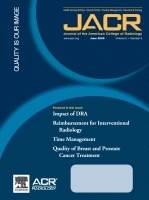How Badly Has the DRA Impacted Radiologists' Income?
by
Barbara Kram, Editor | June 03, 2009

JACR has important
findings on radiologists' pay
and other topics
Reston, Va. - The Deficit Reduction Act of 2005 (DRA) placed a cap on the technical component of Medicare payments for non-hospital imaging services. The ACR conducted a survey in May and June of 2007 to determine the early effect this legislation had on the professional and technical components of income, income derived from Medicare patients, practice changes resulting from Medicare payment cuts, and outside readings, which is detailed in an article in the June issue of the Journal of the American College of Radiology (JACR, www.jacr.org).
2007 Survey of Radiologists: Source of Income and Impact of the Deficit Reduction Act of 2005, by James W. Moser, Ph.D., and Dawn M. Hastreiter, M.D., Ph.D., reports on the survey results of approximately 600 ACR radiologist members.
An average of about 18% of radiologist income came from technical component sources, which the DRA capped for non-hospital Medicare services since January 1, 2007.
"After implementation of DRA, practices were more likely to lay off staff members and cancel purchases of imaging equipment and less likely to reduce imaging services provided," the authors observed.
The DRA impact translates to an average 18.5% reduction in Medicare payment due to the technical component caps, but the impact varied by modality with MRI most impacted:
-MRI: 34.3% reduction
-Interventional radiology: 16.6% reduction
-Ultrasound: 15.5% reduction
-Radiation oncology: 13.1% reduction
-X-ray: 12.5% reduction
-Nuclear medicine: 12.2%
-CT: 10.9% reduction
"Clearly, the vulnerability of radiologists' income to the DRA's technical-component payment caps is related to the portions of their incomes that come from technical-component sources and to the particular imaging modalities from which they derive their incomes," the authors conclude.
In assessing the DRA impact, the direct Medicare reimbursement cuts may be small but private payers typically adopt similar cuts, vastly increasing their impact.
Other Studies Published in JACR
In Reimbursement Trends for Outpatient Interventional Radiology Procedures: Comparison of Hospital and Freestanding Physician Office Sites of Service, by Adam D. Talenfeld, M.D., et al., two main factors are identified as affecting interventional radiology practice: downward-trending reimbursement under the Medicare Physician Fee Schedule, and the prevalence of nonradiologist specialists performing IR procedures. The study authors project that reimbursements will fall by 36 percent in freestanding offices during the 2006-2010 time period, and by 16 percent in hospital outpatient departments. Arteriovenous fistula declotting was the most frequently reported interventional radiology procedure, and was performed by radiologists four times as frequently as the next most commonly reported procedure, the peripheral insertion of a central venous catheter.
